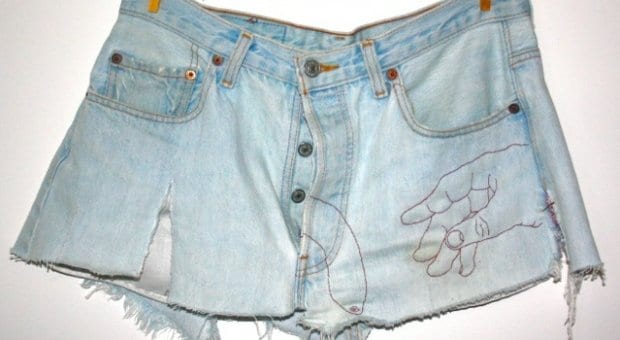Before leather, before rubber, maybe even before jockstraps, the world’s first gay fetish gear was probably Levi’s 501 jeans. The utilitarian item, unique in its combination of un-shrunk denim and riveted stress points, was first crafted in the 1890s as a long-lasting pant for the workingman. Originally the property of cowboys and railroad workers, from the 1950s onward the garment was adopted as a symbol of rebellion and sexual freedom by various subcultures, from gays to mods to skinheads, eventually becoming the world’s best-selling clothing item.
Artist Philip Hare’s current project, The Recreation of Adam, sees him turn this fetish object into art. The first in a series of pieces, the work is constructed from a stack of used 501s he procured from an older gay couple who were cleaning house, prior to moving to Vancouver, where they were planning to live out their golden years.
“They had a massive collection they’d been using as fetish wear for a long time,” Hare says. “When they decided to move, I was first in line for the jeans. I received four or five banker’s boxes. Some of the jeans were almost white, they’d been worn and washed so many times. Some were stained, some so torn to shreds they were almost turned into skirts.”
The work isn’t a departure for Hare; he’s been working with discarded textiles for nearly a decade. For him, the materials are more than just a canvas. They’re the embodiment of queer sexuality, containing the memories of numerous sexual exploits in their fibres — and occasionally, the resulting fluids. Symbolic of a time gone by, they also provide a living link to gay sexuality.
“I’m fascinated by our relationship with clothing and self-adornment and specifically the associations we make between ourselves and our clothing,” he says. “I wanted to play on the idea of telling stories from a queer perspective that would be passed on to another generation. 501s have been a part of gay identity for a long time, and I’d wanted to work with them for a while.”
The work’s title is a nod to the holy status often ascribed to fetish objects in gay culture; it references Michelangelo’s The Creation of Adam from the ceiling of the Sistine Chapel, playing on the idea of the hand of God giving life to his creation. So how did a garment, designed entirely for its practicality, become an object inspiring near-religious devotion in gay sex culture?
“I think Midnight Cowboy might have had something to do with it,” he says with a laugh. “But that may just be my fantasy about Jon Voight as a young hustler.”
Philip Hare’s work appears as part of The Sex Show, which runs Thurs, Feb 6–Sun, Feb 16
Gallery 1313, 1313 Queen St W
g1313.org
philiphare.com


 Why you can trust Xtra
Why you can trust Xtra


